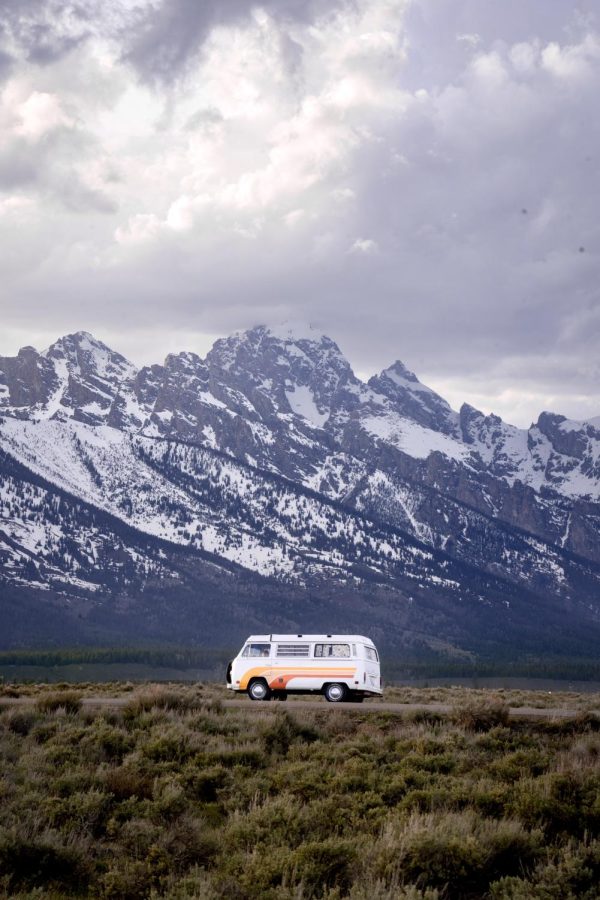Life on Wheels
Unpacking the true van life experience and adventure on and off the road
Living wherever you want, whenever you want, is a lifestyle that has grown in popularity over the past few years. The rising trend of “van life” on social media showcases a way to work from home while traveling the world on wheels, for those seeking a more adventurous lifestyle. As the popularity of van life soars, influencers are posting about their own experiences with it, prompting another increase in popularity. While for some, the appeal comes from the freedom, for others, it is a way to save money on rent or other living costs.
Van life influencer Hannah Sawatzki and her partner Hunter Adams have been able to make a career out of living in a van.
“Together we create content and sell photos we take on the road to brands that are looking for images and films of their products in outdoor settings,” Sawatzki said. “Being able to grow our portfolio and Instagram account has allowed us to reach larger clients and truly be creative with the work we make as we strive to also make videos and share our journey in ways that make us happy as well.”
Social media has had a big influence in the rise in popularity of van life. Seeing various influencers such as Sawatzki encourages people interested in traveling to pursue the experience.
“I had seen these huge vans on Pinterest and Instagram, and so I was like, ‘Hey, I kind of want to do this, we should do this,’” Allison Richards said, owner and co-founder of Safe + Sonder Vans.
Like Sawtatzki, Richards has created a career out of the van life experience. Richards and her partner started a business in 2021 to create custom vans for clients. They now have created over 33 vans on the road.
“Once we started traveling quite often a lot of people were like, ‘Hey, I want [a van], can you build me one or how much does it cost?’ And so we thought, what if we could buy one and sell one,” Richards said. “So we bought one and up-fitted it, built it and sold it for a fraction of the cost of what they go for now. And then we just kind of kept snowballing.”
Beyond the ability for some to find a career in the lifestyle, van life appeals to many as it allows people flexibility with their schedules.
“The freedom is nice and you don’t have to say you’re staying at a hotel, it’s not go to point A, travel to point B, point C and then we have to go all the way back to point A,” Richards said. “You have the freedom to just go wherever you want within your means.”
Being able to go anywhere spontaneously is an appealing aspect of van life. Not having to book hotel rooms or flights allows a person to decide where and when they want to travel at the last minute.
“You get to go wherever you want and you aren’t tied down anywhere,” senior Mads Ernst said. “Because you are on your own timeframe, you can decide how long you stay in each place. This allows you to explore new places as in depth as you want.”
Sawatzki has also enjoyed the benefit of not being tied down in one place. Being on their own time frames allows people who live in vans to thoroughly experience the locations visited.
“We can now spend time in places long enough to learn more about them and appreciate the details, while also slowly making our way through towns and states we would never have normally chosen as a vacation spot when our time off work was limited, “ Sawatzki said. “[Van life] has given us a deeper love for the beauty of the USA and a stronger appreciation of the in-between places we never would have visited otherwise.”
Bay Area resident Genevieve Cadwalader owns a sprinter van with her partner, which they use for weekend trips with their two young kids, but don’t live in full time.
“The main reason we got it is to facilitate outdoor adventures with our kids,” Cadwalader said. “Having it has given us freedom and flexibility to show them so much of why we love living in the Bay Area. I can’t think of anything I don’t like about having our van.”
While Cadawalder hasn’t found any downsides to her families’ version of van life yet, she acknowledges there are some less glamorous tasks that accompany full time van life.
“There’s also the gas station stops, cleaning up the mud you tracked in, how quickly it looks like a mess if things aren’t put back in their specific spots, not to mention some of the very unglamorous spots you sometimes find yourself having to spend the night in,” Cadawalder said.
To troubleshoot some of the more difficult aspects of van life, there are now many resources people can use to make the experience easier. Many apps like iOverlander, Campendium and Sēkr have been created to help with common struggles such as finding a place to sleep.
“You have your own freedom to travel where you want and then open up an app and say, ‘Oh, we need to fill up our water’ or ‘We need to charge up’ or ‘We’re looking for a free place to sleep,’” Richards said. “You can kind of just punch in your location and see what’s around you.”
The major appeal of van life is the ability to travel and explore all around the country. People traveling in a van can visit national parks, different states and even other countries.
“We have explored most of the west half of the US, driving over 20,000 miles in 2022,” Sawatzki said. “We have visited 22 national parks and are currently a month into exploring Baja, Mexico for the first time. We plan to head back to the US, head up to the Pacific Northwest this summer [and] then potentially head into Canada while the weather is still warm.”
Ernst participated in a summer camp in 2021 where she and a group of other teens traveled by bus across the country, starting in North Carolina and traveling as far as California.
“We were living out of vans and we slept under the stars, and it was one of the most incredible experiences of my life,” Ernst said. “It made me realize that I could totally do that if I wanted to.”
Though van life has major advantages, it is not perfect. Because you are not staying at hotels and planned locations, it can be hard to find everything you need when you want to stop for the night.
“I would say probably the biggest disadvantage of [van life] is [that] you’re constantly having to search for a place to sleep, or search for your water,” Richards said.
Van life can additionally take a toll on the relationships between the people participating in it. Being confined to a small space while traveling brings intrapersonal hardships.
“Hunter and I sharing one of the smallest vans possible has definitely tested our relationship and forced us to always be as kind and patient as possible with one another; we have seen many couples not make it out after moving into a van together,” Sawatzki said.
Personal relationships aside, van life also has a strong and loving community surrounding it.
“We can’t go anywhere without someone asking us about our build or wanting to chat,” Cadawalder said. “It’s been a great way to meet and engage with people.”
Whether it be in person at camp grounds or over social media, van lifers are able to connect through their shared experiences and love for their lifestyle. At other times, however, social media can amplify the over-glamorization of van life. Seeing carefully curated and edited photos and videos of this experience tends to cause people to only think about the positives and ignore the downsides.
“I think glamorizing, in a negative [light], would be that a lot of times, [social media] doesn’t show the reality of [van life],” Richards said. “It doesn’t show if you don’t have a heater installed, how cold it could be. If you don’t have an air conditioner, how hot it could be. It doesn’t show the stress of not being able to find a shower in a couple days.”
Furthermore, this glamorization of van life can cause disregard for people with no other options than living in vans or cars.
“I think [the glorification of van life] is pretty intense,” Ernst said. “A lot of people don’t have a choice. They physically cannot live in a house because they don’t have the money for it. For a lot of people, [living in a van] is really not a fun experience. People are forced to live in their car, and [social media can] act like everyone who [lives in a van] is living their lives to the fullest.”
However, that is not to say that glamorizing van life is all bad. Allowing others to see and hear about van lifers’ experiences can inspire them to potentially try their own adventures.
“I would say in a positive light, the glamorizing [of van life] gives people the ability to realize that you’re able to do this,” Richards said. “[Like,] I could do this too and I could go visit these beautiful places I didn’t even know existed.”
The van life experience is multi-faceted and allows people to explore new locations in a unique way. With exposure on social media, appreciation for travel destinations has increased, but along with it, the popularity brings a greater destruction. If you choose to partake in this adventure, it is important to keep some things in mind.
“Be mindful of where you travel to and the places you visit,” Richards said. “Being [careful] of your footprint and understanding the emissions that you might be putting into the air with how much you travel [is important]. Balance your respect for Mother Earth and everything as you are out there exploring and appreciating her.”
Photo by Hannah Sawtatzki
Print Issue
Please click on the three vertical dots on the top right-hand corner, then select “Two page view.”

2021-2022 - Staff Writer
2022-2023 - Managing Editor
I joined C Mag because it seems like an amazing opportunity to be able to be creative and write...

2022-2023 Staff Writer
2023-2024 Editor-in-Chief
I joined C Mag because it is a great community on campus! My favorite part about being a part of...







